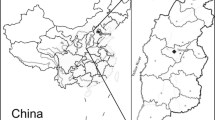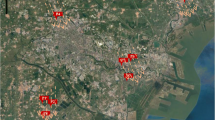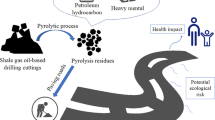Abstract
Waste oil-based drill cuttings contain dioxins and volatile organic compounds (VOCs), which have the potential to cause serious health effects in humans. Therefore, this paper took oil-based drill cuttings (OBDCs) as the research object and carried out the testing of VOCs and dioxins content by using GC–MS and HRGCS-HRMS and comprehensively evaluated the content, composition and distribution pattern of VOCs and dioxins and the risk to human health posed by the two pollutants in OBDCs. The results showed that the VOCs did not exceed the emission limits in ESPPI (GB 31571–2015), but it is vital to recognise that 1,2-dichloropropane has the potential to cause cancer risk, with soil and groundwater risk control values of 662.95 mg·kg−1 and 0.066 mg·kg−1, respectively. Benzene, 1,2-dichloropropane and 8 other VOCs pose a non-carcinogenic risk to humans. The levels of polychlorinated dibenzofurans (PCDFs) exceeded those of polychlorinated dibenzo-p-dioxins (PCDDs), which accounted for 95.76 percent of the total PCDD/Fs, 2,3,4,7,8-P5CDF (56.00%), 2,3,7,8-T4CDF (9.20%), 1,2,3,6,7,8-H6CDF (8.80%) and 1,2,3,7,8-P5CDF (8.00%) were the main contributing monomers. The findings of the assessment on exposure risk indicate that there is a respiratory risk to oil-based drill cuttings dioxins for adults and children exceeded the World Health Organisation (WHO) acceptable daily intake (ADI) (1–4 pgTEQ/kg/d). Finally, three aspects of solid waste pre-treatment prior to incineration, the incineration process and post incineration were used to reduce the environmental and human health risks from dioxins.







Similar content being viewed by others
Data availability
All data generated or analysed during this study are included in this published article.
Abbreviations
- VOCs:
-
Volatile organic compounds
- OBDCs:
-
Oil-based drill cuttings
- ESPPI:
-
Emission standards for pollutants in the petrochemical industry
- PCDFs:
-
Polychlorinated dibenzofurans
- PCDDs:
-
Polychlorinated dibenzo-p-dioxins
- WHO:
-
World Health Organisation
- ADI:
-
Acceptable daily intake
- GC-MS:
-
Gas chromatography-mass spectrometry
- HRGCS-HRMS:
-
High-resolution gas chromatography-high resolution mass spectrometry
- USEPA:
-
The United States Environmental Protection Agency
- HI:
-
Hazard index
- ILCR:
-
Lifetime cancer risk
- EB:
-
Ethylbenzene
- MX:
-
M-Xylene
- OX:
-
O-Xylene
- IPB:
-
Isopropylbenzene
- 1,3,5-TMB:
-
1,3,5-Trimethylbenzene
- 1,2-DCP:
-
1,2-Dichloropropane
- DCM:
-
Dichloromethane
- PhH:
-
Benzene
- PhMe:
-
Toluene
- PERC:
-
Tetrachloroethylene
- MCB:
-
Chlorobenzene
- EB:
-
Ethylbenzene
- 2,3,7,8-T4CDF:
-
2,3,7,8-Tetrachlorodibenzofuran
- 1,2,3,7,8-P5CDF:
-
1,2,3,7,8-Pentachlorodibenzofuran
- 2,3,4,7,8-P5CDF:
-
2,3,4,7,8-Pentachlorodibenzofuran
- 1,2,3,4,7,8-H6CDF:
-
1,2,3,4,7,8-Hexachlorodibenzofuran
- 2,3,4,6,7,8-H6CDF:
-
2,3,4,6,7,8-Hexachlorodibenzofuran
- 1,2,3,7,8,9-H6CDF:
-
1,2,3,7,8,9-Hexachlorodibenzofuran
- 1,2,3,4,6,7,8-H7CDF:
-
1,2,3,4,6,7,8-Heptachlorodibenzofuran
- 1,2,3,4,7,8,9-H7CDF:
-
1,2,3,4,7,8,9-Heptachlorodibenzofuran
- O8CDF:
-
Octachlorodibenzofuran
- 2,3,7,8-T4CDD:
-
2,3,7,8-Tetrachlorodibenzo-p-dioxins
- 1,2,3,7,8-P5CDD:
-
1,2,3,7,8-Pentachlorodibenzo-p-dioxins
- 1,2,3,4,7,8-H6CDD:
-
1,2,3,4,7,8-Hexachlorodibenzo-p-dioxins
- 1,2,3,6,7,8-H6CDD:
-
1,2,3,6,7,8-Hexachlorodibenzo-p-dioxins
- 1,2,3,7,8,9-H6CDD:
-
1,2,3,7,8,9-Hexachlorodibenzo-p-dioxins
- 1,2,3,4,6,7,8-H7CDD:
-
1,2,3,4,7,8,9-Heptachlorodibenzo-p-dioxins
- O8CDD:
-
Octachlorodibenzo-p-dioxin
References
Abdul-Wahab SA, Al-Dhamri H, Ram G, Black L (2020) The use of oil-based mud cuttings as an alternative raw material to produce high sulfate-resistant oil well cement. Jclean Prod 269:122207. https://doi.org/10.1016/j.jclepro.2020.122207
Araka PP, Okparanma NR, Ayotamuno JM (2019) Diagnostic screening of organic contaminant level in solidified/stabilized pre-treated oil-based drill cuttings. Heliyon 5(10):e02644. https://doi.org/10.1016/j.heliyon.2019.e02644
Ayati B, Molineux C, Newport D, Cheeseman C (2019) Manufacture and performance of lightweight aggregate from waste drill cuttings. J Clean Prod 208:252–260. https://doi.org/10.1016/j.jclepro.2018.10.134
Ball AS, Stewart RJ, Schliephake K (2012) A review of the current options for the treatment and safe disposal of drill cuttings. Waste Manag Res 30(5):457–473. https://doi.org/10.1177/0734242X11419892
Bari MA, Kindzierski WB (2018) Ambient volatile organic compounds (VOCs) in Calgary, Alberta: sources and screening health risk assessment. Sci Total Environ 631–632:627–640. https://doi.org/10.1016/j.scitotenv.2018.03.023
Chen Z, Tang M, Lu S, Ding J, Qiu Q, Yan J et al (2018) Evolution of PCDD/F-signatures during mechanochemical degradation in municipal solid waste incineration filter ash. Chemosphere 208:176–184. https://doi.org/10.1016/j.chemosphere.2018.05.161
Chen Z, Li D, Tong K, Chen Z, Chen H, Xu Y et al (2019) Static decontamination of oil-based drill cuttings with pressurized hot water using response surface methodology. Environ Sci Pollut R 26(7):7216–7227. https://doi.org/10.1007/s11356-018-04102-0
Chen Z, Zhang S, Lin X, Li X (2020a) Decomposition and reformation pathways of PCDD/Fs during thermal treatment of municipal solid waste incineration fly ash. J Hazard Mater 394:122526. https://doi.org/10.1016/j.jhazmat.2020.122526
Chen Z, Yu G, Zou X, Wang Y (2020b) Co-disposal of incineration fly ash and sewage sludge via hydrothermal treatment combined with pyrolysis: Cl removal and PCDD/F detoxification. Chemosphere 260:127632. https://doi.org/10.1016/j.chemosphere.2020.127632
Chen X, Yang Y, Lu Z, Chen K, Li Y, Wang X et al (2023a) Oil-based drilling cuttings pyrolysis residues at a typical shale gas drilling field in Chongqing: pollution characteristics and environmental risk assessment. Environ Geochem Hlth 45(06):2949–2962. https://doi.org/10.1007/s10653-022-01388-5
Chen XL, Mu SQ, Luo YF (2023b) Degradation of petroleum pollutants in oil-based drilling cuttings using an Fe2+-based Fenton-like advanced oxidation processes. Environ Sci Pollut R 30:37669–37678. https://doi.org/10.1007/s11356-022-24925-2
Cheng X, Liu K, Zhang X, Li Z, Guo X (2018) Integrity changes of cement sheath due to contamination by drilling fluid. Adv Cem Res 30(2):47–55. https://doi.org/10.1680/jadcr.16.00121
Cong Y, Hong Y, Wang D, Cheng P, Wang Z, Xu G et al (2022) 2,3,7,8-Tetrachlorodibenzo-dioxin induces liver lipid metabolism disorder via the ROS/AMPK/CD36 signaling pathway. Toxicol Sci 191(2):276–284. https://doi.org/10.1093/TOXSCI/KFAC133
de Almeida PC, Araújo ODF, de Medeiros JL (2017) Managing offshore drill cuttings waste for improved sustainability. J Clean Prod 165(1):143–156. https://doi.org/10.1016/j.jclepro.2017.07.062
Dopico M, Gómez A (2015) Review of the current state and main sources of dioxins around the world. J Air Waste Manag 65:1033–1049. https://doi.org/10.1080/10962247.2015.1058869
Faried AS, Mostafa SA, Tayeh BA, Tawfik TA (2021) Mechanical and durability properties of ultra-high performance concrete incorporated with various nano waste materials under different curing conditions. J Build Eng 43:102569. https://doi.org/10.1016/j.jobe.2021.102569
Gao SK, Dong DZ, Tao K, Guo W, Li XJ, Zhang SR (2021) Experiences and lessons learned from China’s shale gas development: 2005–2019. J Nat Gas Sci Eng 85:103648. https://doi.org/10.1016/j.jngse.2020.103648
Gaspard E, Frenoy P, Praud D, Coudon T, Grassot L, Besson C et al (2023) Association between cumulative airborne dioxin exposure and non-Hodgkin’s lymphoma risk in a nested case-control study within the French E3N cohort. Sci Total Environ 906:167330. https://doi.org/10.1016/j.scitotenv.2023.167330
GB 31571-2015 (2015) Emission standard of pollutants for petroleum chemistry industry. General Administration of quality supervision, inspection and Quarantine, China, Beijing
HJ 77.2-2008 (2008) Ambient air and waste gas Determination of polychlorinated dibenzo-p-dioxins(PCDDs)and polychlorinated dibenzofurans(PCDFs)Isotope dilution HRGC-HRMS. Ministry of environmental protection, China, Beijing
HJ 605-2011 (2011) Soil and sediment-determination of volatile organic compounds-purge and trap gas chromatography/mass spectrometry method. Ministry of environmental protection, China, Beijing
HJ 25.3-2014 (2014) Technical guidelines for risk assessment of contaminated sites. Ministry of environmental protection, China, Beijing
HJ 298-2019 (2019) Technical specifications on identification for hazardous waste. Ministry of environmental protection, China, Beijing
Hu G, Liu H, Rana A, Li J, Bikass S, Sadiq R et al (2021) Life cycle assessment of low-temperature thermal desorption-based technologies for drill cuttings treatment. J Hazard Mater 401:123865. https://doi.org/10.1016/j.jhazmat.2020.123865
Huang Z, Xu Z, Quan Y, Jia H, Li J, Pu K et al (2018) A review of treatment methods for oil-based drill cuttings. In: IOP Conf Ser: Earth Environ Sci 170(2):022074. https://doi.org/10.1088/1755-1315/170/2/022074
Jiang H, Hou R, Zhang Z, Lin Y, Zhao Z, Li H et al (2021) Removal of pollution from the chemical looping process: a mini review. Fuel Process Technol 221:106937. https://doi.org/10.1016/j.fuproc.2021.106937
Lam G, Juricek L, Dayal H, Laserna AKC, Hichor M, Li SFY et al (2022) Toxicological effects of 2,3,7,8 tetrachlorodibenzo-p-dioxin on the skeletal muscle of mice during the perinatal period: a metabolomics study. Environ Sci Eur 34(01):57–57. https://doi.org/10.1186/s12302-022-00633-z
Lee JE, Ok YS, Tsang DC, Song J, Jung SC, Park YK (2020) Recent advances in volatile organic compounds abatement by catalysis and catalytic hybrid processes: a critical review. Sci Total Environ 719:137405. https://doi.org/10.1016/j.scitotenv.2020.137405
Liu T, Tian L, Yang L, Yan D, Huang Q, Huang Z (2022) Emissions of BTEXs, NMHC, PAHs, and PCDD/Fs from co-processing of oil-based drilling cuttings in brick kilns. J Environ Manag 304:114170. https://doi.org/10.1016/j.jenvman.2021.114170
Ma J, Yang Y, Dai X, Chen Y, Deng H, Yan G (2016) Effects of adding bulking agent, inorganic nutrient and microbial inocula on biopile treatment for oil-field drilling waste. Chemosphere 150:17–23. https://doi.org/10.1016/j.chemosphere.2016.01.123
Ma Y, Shao F, Fu SB, Yue CT, Xu DL (2023) Study of pyrolysis characteristics and kinetics of oil-based drill cuttings. J Therm Anal Calorim 148:9561–9670. https://doi.org/10.1007/s10973-023-12318-7
Nagarajan V, Ramesh R, Chandiramouli R (2023) Chemical sensing properties of σ-PXene sheets towards dioxin vapours-a first-principles insight. Comput Theor Chem 1228:11430. https://doi.org/10.1016/j.comptc.2023.114300
Nouwen J, Cornelis C, Fré RD, Wevers M, Viaene P, Geuzens P et al (2001) Health risk assessment of dioxin emissions from municipal waste incinerators: the Neerlandquarter (Wilrijk, Belgiun). Chemosphere 43(4/7):909–923. https://doi.org/10.1016/S0045-6535(00)00504-X
Qiu Q, Jiang X, Lv G, Chen Z, Lu S, Deng X et al (2019) Degradation of PCDD/Fs in MSWI fly ash using a microwave-assisted hydrothermal process. Chinese J Chem Eng 27(7):1708–1715. https://doi.org/10.1016/j.cjche.2018.10.015
Ratnayake AS, Sampei Y (2019) Organic geochemical evaluation of contamination tracers in deepwater well rock cuttings from the Mannar Basin, Sri Lanka. J Pet Explor pro Te 9(2):989–996. https://doi.org/10.1007/s13202-018-0575-8
Stanmore BR (2004) The formation of dioxins in combustion systems. Combust Flame 136(3):398–427. https://doi.org/10.1016/j.combustflame.2003.11.004
Take M, Matsumoto M, Takeuchi T, Haresaku M, Kondo H, Fukushima S et al (2014) Inhalation exposure to 1,2-dichloropropane: distribution of blood and tissue concentrations of 1,2-dichloropropane in rats during and after exposure. J Env Sci Heal C-Tox 49(12):1341–1348. https://doi.org/10.1080/10934529.2014.928193
USEPA (2009) Risk assessment guidance for superfund volume I: human health evaluation manual (Part F, supplemental guidance for inhalation risk assessment). Office of Superfund Remediation and Technology Innovation Environmental Protection Agency. EPA-540-R-070-002
USEPA (2018) Integrated risk information system (IRIS), U.S. Environmental Protection Agency, Washington, DC. http://www.epa.gov/iris
Wagrowski DM, Hites RA (2000) Insights into the global distribution of polychlorinated dibenzo-p-dioxins and dibenzofurans. Environ Sci Technol 34(14):2952–2959. https://doi.org/10.1021/es991138o
Wang P, Yan F, Cai J, Xie F, Shen X, Zhang Z et al (2022) Emission levels and phase distributions of PCDD/Fs in a full-scale municipal solid waste incinerator: the impact of wet scrubber system. J Clean Prod 337:130468. https://doi.org/10.1016/j.jclepro.2022.130468
Wang J, Janson C, Gislason T, Gunnbjörnsdottir M, Jogi R, Norbäck D et al (2023) Volatile organic compounds (VOC) in homes associated with asthma and lung function among adults in Northern Europe. Environ Pollut 321:121103. https://doi.org/10.1016/j.envpol.2023.121103
Xie B, Qin J, Sun H, Wang S, Li X (2021) Leaching behavior of polycyclic aromatic hydrocarbons (PAHs) from oil-based residues of shale gas drill cuttings. Environ Pollut 288:117773. https://doi.org/10.1016/j.envpol.2021.117773
Xiong DM, Wang CQ (2022) The pozzolanic activity of calcined oil-based drilling cuttings-aluminosilicate composites. Environ Sci Pollut R 29:80222–80236. https://doi.org/10.1007/s11356-022-23389-8
Xiong DM, Wang CQ, Wang PX, Ding HZ, Yang JL, Qin YJ (2022a) Study on environment-friendly disposal and utilization of oil-based drilling cuttings solidified body of shale gas. Constr Build Mater 327(11):127043. https://doi.org/10.1016/j.conbuildmat.2022.127043
Xiong S, Peng Y, Chen K, Lu S, Jiang W, Cen K et al (2022b) Phase distribution, migration and relationship of polychlorinated dibenzo-p-dioxins and dibenzofurans and heavy metals in a large-scale hazardous waste incinerator. J Clean Prod 341:130764. https://doi.org/10.1016/j.jclepro.2022.130764
Xu S, Chen T, Buekens A, Li X (2018a) De novo formation of PCDD/F during sintering: effect of temperature, granule size and oxygen content. Isij Int 58:566–572. https://doi.org/10.2355/isijinternational.ISIJINT-2017-392
Xu L, Yu J, Wan G, Sun L (2021) Emission characteristics and source identification of polycyclic aromatic hydrocarbons (PAHs) from used mineral oil combustion. Fuel 304:121357. https://doi.org/10.1016/j.fuel.2021.121357
Xu TT, Wang LA, Li T, Zhan XY (2018) Heavy metal pollution and ecological risk assessment of water-based drill cuttings produced in shale gas exploitation in Chongqing, China. 3rd Int Conf Energy Eng Environ Prot (EEEP) 227:062005. https://doi.org/10.1088/1755-1315/227/6/062005
Ying Y, Ma Y, Wang X, Yu H, Wu A, Yin W et al (2023) Emission, partition, and formation pathway of polychlorinated dibenzo-p-dioxins and dibenzofurans during co-disposal of industrial waste with municipal solid waste. J Environ Chem Eng 11(1):109242. https://doi.org/10.1016/j.jece.2022.109242
Zhang H, Hou J, Wang Y, Tang P, Zhang Y, Tang Y et al (2017a) Adsorption behavior of 2,3,7, 8-tetrachlorodibenzo-p-dioxin on pristine and doped black phosphorene: A DFT study. Chemosphere 185:509–517. https://doi.org/10.1016/j.chemosphere.2017.06.120
Zhang X, Xue Z, Li H, Yan L, Yang Y, Zhang W (2017b) Ambient volatile organic compounds pollution in China. J Environ Sci 55:69–75. https://doi.org/10.1016/j.jes.2016.05.036
Zhang K, Li L, Huang L, Wang Y, Huo J, Fu Q et al (2020) The impact of volatile organic compounds on ozone formation in the suburban area of Shanghai. Atmos Environ 232:177511. https://doi.org/10.1016/j.atmosenv.2020.117511
Zhang G, Zhao F, Cheng X, Huang S, Zhang C, Zhang L et al (2022) Resource utilization from solid waste originated from oil-based shale drilling cutting during shale gas development. Chemosphere 298:134318. https://doi.org/10.1016/j.chemosphere.2022.134318
Zhao F, Fan Y, Zhang SH (2021) Assessment of efficiency improvement and emission mitigation potentials in China’s petroleum refining industry. J Clean Prod 280(2):124482. https://doi.org/10.1016/j.jclepro.2020.124482
Zhao B, Hu X, Lu J (2022) Analysis and discussion on formation and control of dioxins generated from municipal solid waste incineration process. J Air Waste Manag 72(10):20–21. https://doi.org/10.1080/10962247.2022.2100843
Funding
This study was funded by science and technology research project of Chongqing Municipal Education Commission of China (KJQN202100723), Open Project of State Key Laboratory of Solid Waste Reuse for Building Materials (SWR-2023–003) and Key Special Project of Technology Innovation and Application Development of Chongqing, China (CSTB2023TIAD-KPX0074).
Author information
Authors and Affiliations
Contributions
Chao-qiang Wang mainly contribute to material preparation, manuscript preparation and manuscript editing and revision mainly. Yan Ying contribute to study design, experimental studies, data analysis and manuscript editing and revision. Xu-dong Mei mainly contribute to manuscript editing and experimental design. Feng-lin Xu mainly contribute to manuscript editing and experimental design. Zhong Chen mainly contribute to manuscript editing and experimental design. All authors read and approved the final manuscript.
Corresponding author
Ethics declarations
Ethical approval
This study does not contain any studies with human participants and/or animals.
Consent to participate
Written informed consent was obtained from individual participants.
Consent for publication
Not applicable.
Competing interests
The authors declare no competing interests.
Additional information
Responsible Editor: Lotfi Aleya
Publisher's Note
Springer Nature remains neutral with regard to jurisdictional claims in published maps and institutional affiliations.
Rights and permissions
Springer Nature or its licensor (e.g. a society or other partner) holds exclusive rights to this article under a publishing agreement with the author(s) or other rightsholder(s); author self-archiving of the accepted manuscript version of this article is solely governed by the terms of such publishing agreement and applicable law.
About this article
Cite this article
Wang, Cq., Ying, Y., Mei, Xd. et al. Human health risk assessment of volatile organic compounds in oil-based drill cuttings of shale gas. Environ Sci Pollut Res 31, 16092–16105 (2024). https://doi.org/10.1007/s11356-024-32322-0
Received:
Accepted:
Published:
Issue Date:
DOI: https://doi.org/10.1007/s11356-024-32322-0




